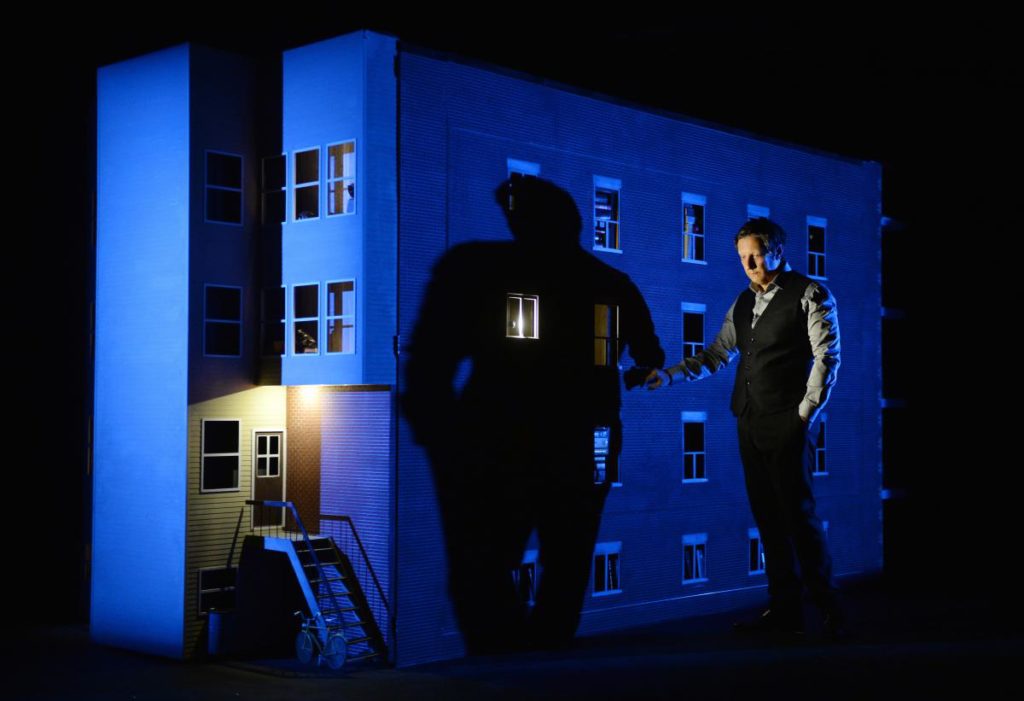887 lepage at the NAC: technology masterfully used to support storytelling

Robert Lepage’s 887, named after his childhood home address, deals with the unstable, vague nature of personal and collective memory. It’s an autobiographical show, in which he recalls his childhood in Québec City during the turbulent 1960s.
Details about his father and his immediate surroundings, as well as the Quiet Revolution and its consequences, frame his childhood and shape his identity, to an extent that surprises even Lepage. The snippets of story are nestled within the frame of the artist’s struggle to remember the words to “Speak White” By Michèle Lalonde, a poem dealing with the cultural and linguistic imperialism of the English-speaking world.
There is no question that Robert Lepage is a brilliantly talented writer, actor, and director. He vividly describes his past with romance and a cozy nostalgia without ever veering into the overwrought. His stunning set and use of technology helps paint a vivid picture while evoking the wonder of the very young. The show could certainly use some tightening up – some transitions are a bit forced – but overall, it’s a funny, warm experience.
887 is a work that can open our eyes to the possibilities of technology masterfully used to support storytelling. Lepage tells his story in front of a beautiful replica of the low-rise apartment building in working class Québec City where he grew up. As he tells of his neighbours’ lives – their jobs, political leanings, and secret longings – the dollhouse windows light up with fleeting movies of these lives. 887 is full of miniatures, dollhouses, dolls, and toy cars – all emblems of childhood that serve to draw the audience even further into Lepage’s magical world. With these tools, Lepage can play with perspective, giving us intimate, as well as historically sweeping representation of events. Lepage also makes liberal use of his smartphone, that modern repository of memory, to check details, as well as record and show events. One particularly poignant moment comes when he uses a pair of boots and his smartphone positioned between them to recreate the fear he felt as a child when soldiers searched him on his paper route during the FLQ crisis. Lepage amazes with technology, but never at the sacrifice of the intimacy that fills the play.
Although the stories are warm and nostalgic, Lepage doesn’t shy away from showing the sometimes harshly delineated differences between French and English. Yet, although the show and the poem that frames it touch heavily on the unfairness and the aggression between the two communities, the story that is told primarily focuses on the struggle between the rich and poor – an inequality that strikes everyone, regardless of race or place of birth. As Lepage said in an interview with the Globe and Mail, “… [the nationalist movement] was a class struggle. It happened that the people who had the power and the money spoke English and the people who didn’t spoke French…” This spirit is evident through the play, which doesn’t contain an ounce of nationalist fervour, but plenty of frustration about differences in class and power, as well as for rash action that breeds “bombs in our minds.” As beautiful as this sentiment is, this is also where the show could use most tightening up. Many of the connections between social events’ influence on Lepage were murky or tenuous. The play explores the fleeting nature of memory very well, but the thesis and connection between events isn’t always clear.
Lepage does end up memorizing Speak White, and recites it with a feeling that is staggeringly poignant – perhaps it is his exploration of his own roots – the not always clear fragments that make up his memory – that he is able to do so. It’s a show well worth seeing, by one of Canada’s best artists.